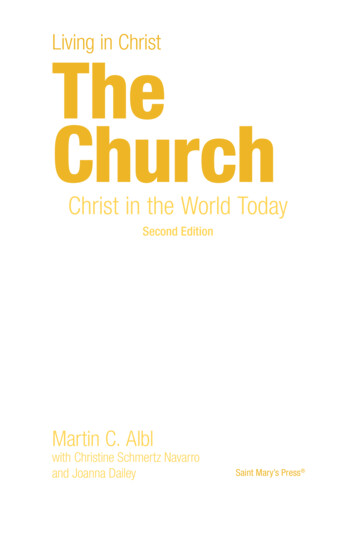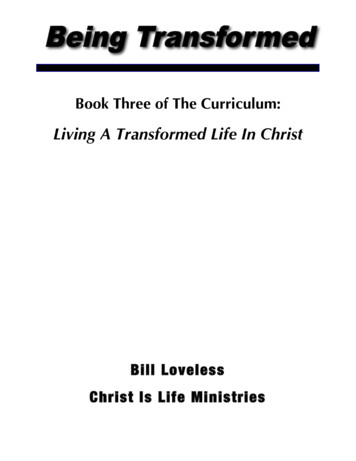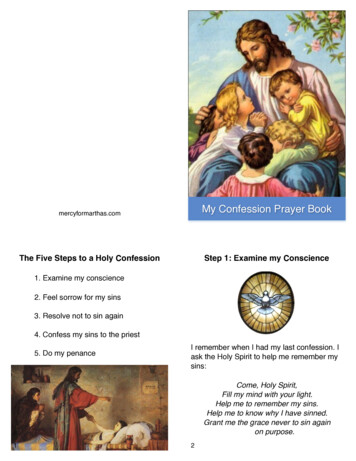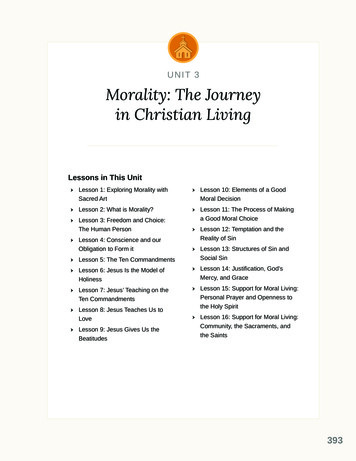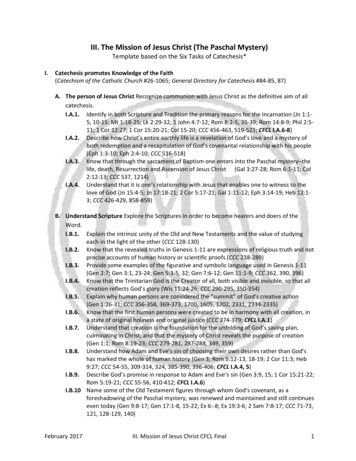
Transcription
Living in ChristThePaschalMysteryChrist’s Mission of SalvationSecond EditionBrian Singer-TownsSaint Mary’s Press
The Subcommittee on the Catechism, United States Conference ofCatholic Bishops, has found that this catechetical high school text, copyright 2016, is in conformity with the Catechism of the Catholic Churchand that it fulfills the requirements of Core Course III of the DoctrinalElements of a Curriculum Framework for the Development of CatecheticalMaterials for Young People of High School Age.Rev. Fr. Timothy J. Hall, STLCensor LibrorumSeptember 30, 2014†Most Rev. John M. Quinn, DDBishop of WinonaSeptember 30, 2014The nihil obstat and imprimatur are official declarations that a book orpamphlet is free of doctrinal or moral error. No implication is containedtherein that those who have granted the nihil obstat or imprimatur agreewith the contents, opinions, or statements expressed, nor do they assumeany legal responsibility associated with publication.The content in this resource was acquired, developed, and reviewed bythe content engagement team at Saint Mary’s Press. Content design andmanufacturing were coordinated by the passionate team of creatives atSaint Mary’s Press.Copyright 2016 by Saint Mary’s Press, Christian Brothers Publications,702 Terrace Heights, Winona, MN 55987-1320, www.smp.org. All rightsreserved. No part of this book may be reproduced by any means withoutthe written permission of the publisher.Printed in the United States of AmericaE1163ISBN 978-1-59982-696-7
ContentsIntroduction . . . . . . . . . . . . . . . . . . . . . . . . . . . . . . . . . . . 6Unit 1 God’s Plan for Salvation:The Big PictureChapter 1 The Goodness of Creation. . . . . . . . . . . . . . 10Article 1 The Primeval History . . . . . . . . . . . . . . . . . . . . . . 11Article 2 Creation Reflects the Glory of God . . . . . . . . . . . 15Article 3 Human Beings: The Summit of Creation. . . . . . . 18Article 4 The Garden of Eden: The Perfect Life. . . . . . . . . 22Chapter 2 The Fall from Grace. . . . . . . . . . . . . . . . . . . 25Article 5 Adam and Eve’s Disobedience . . . . . . . . . . . . . . 26Article 6 Original Sin: A Consequence of the Fall . . . . . . . 29Article 7 Satan and the Fallen Angels . . . . . . . . . . . . . . . . 33Chapter 3 The Path to Restoration. . . . . . . . . . . . . . . . 37Article 8 God’s Promise to Adam and Eve. . . . . . . . . . . . . 38Article 9 The Old Testament Covenants. . . . . . . . . . . . . . . 41Article 10 Covenant Keeping: Successes and Failures. . . . 49Article 11 The Growing Messianic Hope . . . . . . . . . . . . . . . 53Unit 2 Jesus Christ’s Mission Is RevealedChapter 4 The Word Became Flesh. . . . . . . . . . . . . . . 58Article 12 God Prepares the Way:The Roles of Mary and Joseph . . . . . . . . . . . . . . 59Article 13 The Gospels andChristological Prophecies . . . . . . . . . . . . . . . . . . 63Article 14 Why the Word Became Flesh. . . . . . . . . . . . . . . . 66Article 15 The Titles Say It All. . . . . . . . . . . . . . . . . . . . . . . . 70
Chapter 5 The Redemptive Natureof Christ’s Earthly Life. . . . . . . . . . . . . . . . . . . . . . . . . . . . 74Article 16 The Luminous Mysteries . . . . . . . . . . . . . . . . . . . 75Article 17 Jesus’ Humble Beginnings . . . . . . . . . . . . . . . . . 80Article 18 Christ’s Obedience. . . . . . . . . . . . . . . . . . . . . . . . 84Article 19 Christ’s Moral Teaching . . . . . . . . . . . . . . . . . . . . 86Article 20 Christ’s Healings . . . . . . . . . . . . . . . . . . . . . . . . . 91Unit 3 God’s Plan for Salvation Is FulfilledChapter 6 The Suffering and Death of Jesus. . . . . . . . 98Article 21 The Events of the Passion. . . . . . . . . . . . . . . . . . 99Article 22 Who Killed Jesus?. . . . . . . . . . . . . . . . . . . . . . . 105Article 23 The Meaning of the Cross . . . . . . . . . . . . . . . . . 110Article 24 Why Did the Father AllowHis Son to Suffer? . . . . . . . . . . . . . . . . . . . . . . . 115Chapter 7 The Resurrectionand Ascension of Jesus . . . . . . . . . . . . . . . . . . . . . . . . . 117Article 25 The Events of the Resurrection . . . . . . . . . . . . . 118Article 26 What Does Resurrection Mean? . . . . . . . . . . . . 123Article 27 The Significance of Christ’s Resurrection . . . . . 128Article 28 The Ascension . . . . . . . . . . . . . . . . . . . . . . . . . . 131Chapter 8 Redeemed by Christ:Our Eternal Destiny. . . . . . . . . . . . . . . . . . . . . . . . . . . . . 139Article 29 Saved from What?. . . . . . . . . . . . . . . . . . . . . . . 140Article 30 Saved for What?. . . . . . . . . . . . . . . . . . . . . . . . . 142Article 31 Our Judgment by God. . . . . . . . . . . . . . . . . . . . 146Article 32 Where Do We Go after Death?. . . . . . . . . . . . . . 151Unit 4 The Paschal Mystery and Your LifeChapter 9 Living as a Disciple . . . . . . . . . . . . . . . . . . 160Article 33 Our Call to Holiness. . . . . . . . . . . . . . . . . . . . . . 161
Article 34 Our Call to Participate in Christ’sPriestly, Prophetic, and Kingly Ministry. . . . . . . 165Article 35 Participating in Christ’s Priestly Ministry . . . . . . 166Article 36 Participating in Christ’sProphetic Ministry . . . . . . . . . . . . . . . . . . . . . . . 172Article 37 Participating in Christ’s Kingly Ministry. . . . . . . 176Chapter 10 Suffering and the Paschal Mystery. . . . . . 183Article 38 Making Sense of Suffering. . . . . . . . . . . . . . . . . 184Article 39 Is Accepting Sufferinga Sign of Weakness?. . . . . . . . . . . . . . . . . . . . . 188Article 40 Finding Strength in Times of Suffering. . . . . . . . 192Article 41 The Promise of the Paschal Mysteryin Times of Suffering . . . . . . . . . . . . . . . . . . . . . 196Unit 5 Prayer and the Paschal MysteryChapter 11 The Fundamentals of Prayer. . . . . . . . . . . 200Article 42 Why We Pray . . . . . . . . . . . . . . . . . . . . . . . . . . . 201Article 43 The Forms of Prayer. . . . . . . . . . . . . . . . . . . . . . 205Article 44 Three Expressions of Prayer . . . . . . . . . . . . . . . 210Article 45 Overcoming Obstacles to Prayer. . . . . . . . . . . . 213Article 46 Ignatian Gospel Meditation . . . . . . . . . . . . . . . . 218Chapter 12 Praying the Triduum . . . . . . . . . . . . . . . . . 224Article 47 The Paschal Mystery, Liturgy,and the Triduum. . . . . . . . . . . . . . . . . . . . . . . . . 225Article 48 Holy Thursday . . . . . . . . . . . . . . . . . . . . . . . . . . 230Article 49 Good Friday. . . . . . . . . . . . . . . . . . . . . . . . . . . . 235Article 50 Easter Vigil. . . . . . . . . . . . . . . . . . . . . . . . . . . . . 238Glossary . . . . . . . . . . . . . . . . . . . . . . . . . . . . . . . . . . . 244Acknowledgments . . . . . . . . . . . . . . . . . . . . . . . . . . . . 254
6IntroductionIntroductionWhen I was a young man, I spent several years searching for something Ididn’t know I had lost. From birth I grew up in a devout Catholic family, as a teen I was an altar server and lector in my parish, and as a collegestudent I continued to attend Mass every Sunday. But after a while, I feltlike I was just going through the motions. If you were to see the brave faceI presented to the world, you would have thought I was just fine. But insideI was a confused and lonely person.What I didn’t know then was that deep inside myself, in my soul, Iwas missing a crucial connection with God. I tried to fill that void in manyways. I tried making new friends, joining new groups, and reading aboutdifferent religions. But it wasn’t until I joined a Bible study group that wasreading the Gospel of Mark that I found what my soul was missing: a closeand intimate relationship with the Trinity—the Father, Son, and HolySpirit.I share this story because there is a danger in writing a student bookabout Jesus Christ. The danger is that it can make faith in Jesus seemlike just another intellectual exercise, just another subject to master onyour way to adulthood. Yet as I discovered those many years ago, yes,faith involves the intellect, but there is more to it. God wants to be in anintimate relationship of love with each of us. He has worked throughouthistory to reveal that desire and make it possible for us to bridge the “gap”that separates us from his love.The Paschal Mystery is the name we give to the process of God’s planof salvation, which is principally accomplished through the life, death,Resurrection, and Ascension of Jesus Christ. This book explores that plan,from its beginnings in the Garden of Eden to its glorious conclusion at theParousia. We will see how God has been at work throughout all of historyto restore what was lost—our full and intimate communion with the HolyTrinity. Perhaps most important, we will look at how God calls each of usto be an active participant in his plan.When I gave myself over in faith to God’s loving invitation thosemany years ago, my whole life was renewed. I discovered a deeper andmore profound relationship with God. And because of that, I enteredinto deeper and more loving relationships with other people. My faith inChrist saves me from sin and will save me from death. It saves me fromconfusion, loneliness, and despair. Every day it gives my life meaning, joy,and hope even when times are hard and when bad things happen. As amember of the Body of Christ, the Church, I have met and been loved by
Introductionmany amazing and wonderful people, people who inspire me to deepercommitment in my journey of faith.That is what I pray for you. I hope that as you study this book, youtake seriously what it teaches about Jesus Christ and the Paschal Mystery.There is an important intellectual dimension to belief. We must believein the right things, the truths revealed by God. But I also hope this willbe more than an intellectual exercise for you. I pray that you will let thelove of Christ that is expressed in the Paschal Mystery touch your heartand motivate your every action. I pray that you will see your study of thePaschal Mystery as an invitation from God to draw closer to him and tolet this Mystery become the spiritual center of your life. Let God fill thehunger in your soul.Blessings,Brian Singer-Towns7
Unit1God’s Planfor Salvation:The Big PictureIn this unit, we will learn about the creation of theworld and how God’s creation reveals his plan forhumanity. In the beginning, God created the heavensand the earth and all that is in them. Everything thatGod created was good, and it developed according toGod’s plan, which is for us to live in communion withhim and with one another.But we will see that when the first human beingssinned, they broke that communion. What did God dothen? He didn’t just leave us to struggle with sin on ourown. Instead he promised right then and there to saveall of humanity from sin and death.After the Original Sin and the Fall, God put a planin motion to send his Son to redeem humanity andrestore what we lost through sin—communion withGod and eternal life. God’s plan of salvation culminated in the Passion, death, Resurrection, and Ascension of Jesus, the events we call the Paschal Mystery.Throughout the course of salvation history, thepattern of events in which God revealed his presenceand saving actions, God made covenants with his people, to show them that he would always be faithful andthat he would never forsake them. Even though God’speople continued to sin and turn away from him, Goddid not abandon them. God chose to remain faithful tohis covenants, and he sent prophets to continually callGod’s people back to himself.
The enduring understandings and essential questionsrepresent core concepts and questions that are exploredthroughout this unit. By studying the content of eachchapter, you will gain a more complete understandingof the following:Enduring Understandings1. God created the entire world as essentially good.2. Sacred Scripture uses figurative and symbolic language to convey religious truth.3. Original Sin entered the world when Adam and Evechose to reject a God-centered life in favor of a selfcentered life.4. After the Fall, God continued to find a way to communicate his love for humanity and his desire torestore humanity’s communion with him.Essential Questions1. How do we know that the world is essentially good,despite the presence of sin?2. How does Scripture use literary forms to conveyreligious truth?3. If God created the entire world essentially good, why dopeople, beginning with Adam and Eve, choose to sin?4. What characterized God’s relationship with humanityafter the Fall?
Chapter1The Goodnessof CreationIntroductionGod has a plan, and you are a part of it. Modernscience has come a long way in explaining creation,growth, and even the end of stars and galaxies. We havesome intriguing theories, such as the big bang theory,about how the universe came into existence. Throughthe gift of our intellect, we can continue to learn aboutthe workings of the universe; through faith we knowthat the universe was made by God, so we know thatwhat has been created was made out of the uncreated.We begin this chapter by looking at the Scriptureaccounts of Creation. Although these accounts mightnot be scientifically true, we can accept them as religious truth because of what they reveal about God andhis plan for creation. Creation, both visible and invisible, is the work of the Trinity.You will read that God created the universe out oflove. God’s creation is good, and he loves all of it, everyparticle, every grain of sand, every blade of grass, andevery form of life that swims, crawls, walks, or flies.And in his plan, human beings—the summit of God’screation—have a special place. God has made us “littleless than a god, / crowned [us] with glory and honor”(Psalm 8:6). God has a plan and you are a part of it.10
Chapter 1 The Goodness of Creation11Article 1: The Primeval HistoryAs we explore God’s plan, it makes sense to start withhis intention in creating the world in the first place. WasGod bored? Was he lonely? Was he looking for somefree labor? No, no, and no! The creation stories of otherancient cultures claimed these as reasons for why thegods created the earth and human beings. But the twoCreation accounts in Sacred Scripture, found in the firsttwo chapters of the Book of Genesis, give very differentreasons, which makes them special in teaching us aboutCreation. These chapters contain the familiar accounts ofthe six days of Creation, the creation of Adam and Eve,and Adam and Eve’s Fall from grace.Although the two accounts of Creation originated atdifferent times, both reveal important truths about God.God is revealed as the one, true God, who sustains thewhole universe. He created the world out of love, becausehe is Love. He created the world to be good, becausehe is Goodness. He revealed the serpent’s words as lies,because he is Truth. Even after Adam and Eve’s sin, God’slove for humanity remains steadfast and faithful, becausehe is Faithfulness.The two Creation accounts are part of a section ofGenesis (chapters 1–11) called “The Primeval History”in some Bibles. Primeval sounds like prehistoric, and itmeans kind of the same thing. Describing the accounts ofCreation in Genesis as primeval history means that theseare symbolic accounts about things that happened longbefore we have any kind of historical records—written orarchaeological. These texts probably came from several different ancient Jewish sources. By the inspirationof the Holy Spirit, these stories were told, refined, andedited together over the course of severalcenturies before they became the finaltext we have today. Through the primevalhistory, God reveals some very importanttruths that we will take a closer look at inthis chapter.primeval historyThe time beforethe inventionof writing andrecording ofhistorical data. Robert Simon / istockphoto.com
12Unit 1 God’s Plan for Salvation: The Big PictureLiterary Forms in the BibleSacredScriptureThe sacredwritings of theOld and NewTestaments,which containthe truth of God’sRevelation andwere composedby human authorsinspired by theHoly Spirit.literary forms(genres)Different kinds ofwriting determinedby their literarytechnique, content,tone, and purpose.Before examining the meaning of the Creation accountsin Sacred Scripture, it is helpful to understand literary formand how it relates to Scripture. Literary form is alsocalled literary genre. A newspaper, for example, has manyliterary forms: news stories, editorials and opinion pieces,comics, advice columns, sports scores, and many others.They all can teach us something true, but we don’t interpret a comic strip the same way we interpret a front-pagenews story.We must always remember that God is the primaryauthor of Sacred Scripture. But this does not mean thatGod took away the creativity of the human authors, whowere inspired by the Holy Spirit. So Sacred Scripture alsohas many literary forms, including figurative language,hymns, parables, short stories, law codes, hero stories,prophetic oracles, Gospels, letters, proverbs, religioushistories, and even love poetry. God works through allthese different literary forms to reveal his truth. To interpret the Bible’s truth correctly, we must take into accountwhat the human authors intended to communicatethrough the different literary forms as well as what Godwanted to reveal through their words.Religious Truth and Scientific TruthThe primeval history in Sacred Scripture teaches religious truth, not science. We know this because thesechapters are written in figurative language. Figurativelanguage uses symbolicimages, stories, and namesto point to a deeper truth.It can teach us importantreligious truths, but it isusually not meant to bescientifically or historicallyaccurate. So, for example,the seven days of creationin chapter 1 of Genesisteach us that God created Patryk Kosmider / Shutterstock.com
Chapter 1 The Goodness of Creationthe world with order and purpose. But we should notinterpret this story to mean that God literally created theuniverse in six 24-hour days. We should also not interpret figurative language as pure fantasy; the first chaptersof Genesis affirm real events that took place at the beginning of human history.Another example of figurative language is theaccount in Genesis 2:21 in which God made the firstwoman from one of the ribs of the first man. This verseis not trying to teach that God literally made the firstwoman from a piece of the first man. (In an effort to“prove” this, some people even say that men have one lessrib than women, but, of course, this is not true.) Instead,through this text, God reveals that men and women areintimately connected; we are equal, each gender complementing the other. Man and woman are called to be “oneflesh” in the Sacrament of Matrimony.Religious truth and scientific truth ultimately nevercontradict each other. God has given us both our faithand our reason, and he would not cause his gifts to us to13figurativelanguageA literary formthat uses symbolicimages, stories,and names to pointto a deeper truth.Primary SourcesProtecting CreationIn the homily for his inauguration Mass on the Solemnity of Saint Joseph,Pope Francis took his theme from Saint Joseph’s role as protector of theHoly Family. The Pope urged all human beings to be protectors—of the environment and of those who are poor, and those who are in need. The Popesaid:“In [Joseph], dear friends, . . . we also see the core of the Christianvocation, which is Christ! Let us protect Christ in our lives, so that wecan protect others, so that we can protect creation! . . . [This] meansrespecting each of God’s creatures and respecting the environment inwhich we live. It means protecting people, showing loving concern foreach and every person. . . . In the end, everything has been entrusted toour protection, and all of us are responsible for it. Be protectors of God’sgifts!”(“Homily of Pope Francis, Mass, Imposition of the Pallium and Bestowalof the Fisherman’s Ring for the Beginning of the Petrine Ministry of theBishop of Rome,” March 19, 2013)
14Unit 1 God’s Plan for Salvation: The Big Picturebe in conflict. If religion and science seem to contradicteach other, it means that we have misunderstood one orthe other. Trying to interpret the figurative language inthe Bible as scientific truth is a misunderstanding thatcauses an unnecessary conflict between our faith and ourreason.How would you explain the difference between religious truth and scientific truth to a friend?Faith in ActionStudying God’s CreationDeep in the southern Arizona desert,an astronomer searches the skies ashe studies God’s beautiful creation. Thatastronomer is a Jesuit priest, and he isusing one of the two telescopes set in thisobservatory. The larger telescope is runby the University of Arizona. The smallertelescope, run by the Vatican, is known asthe VATT (Vatican Advanced TechnologyTelescope). The only other telescope in the MarcelClemens / Shutterstock.comworld run by the Vatican is in the VaticanObservatory in Rome.The goal of the Vatican Observatory is to promote education and researchopportunities for scientists interested in astronomical research. Why would theChurch be interested in maintaining an observatory? Because we can learn somuch about God and the goodness of creation from studying the world aroundus. In fact, the Church sponsors a special group, the Pontifical Academy of Sciences, consisting of scientists from all over the world. They meet periodically tostudy important topics in science and to share their findings with one another.Pope Benedict XVI considered the work of the Pontifical Academy of Sciences to be of great importance. He said: “I am convinced of the urgent needfor continued dialogue and cooperation between the worlds of science andof faith in the building of a culture of respect for man, for human dignity andfreedom, for the future of our human family and for the long-term sustainabledevelopment of our planet” (“Address of His Holiness Pope Benedict XVI toMembers of the Pontifical Academy of Sciences on the Occasion of the PlenaryAssembly,” November 8, 2012).
Chapter 1 The Goodness of Creation15Article 2: Creation Reflectsthe Glory of GodThroughout all history human beings haverepeatedly experienced a particular kind ofawe-inspiring moment, perhaps while gazing atthe stars, watching the waves on the ocean, orseeing a brilliant sunset. At such moments onemight exclaim aloud or silently, “Praise God!”This is a recognition that creation itself givesglory to the Creator. God created the world toreveal his glory. Every creature is meant to sharein God’s truth, goodness, and beauty.Praise the Lord from the heavens;praise him in the heights.Praise him, all you his angels;give praise, all you his hosts.Praise him, sun and moon;praise him, all shining stars. . . . . . . . . . . . . . .Young men and women too,old and young alike.Let them all praise the Lord’s name,for his name alone is exalted,His majesty above earth and heaven.(Psalm 148:1–3,12–13) Stephen Strathdee / istockphoto.comThis image of Godcreating the sunand the moon isfrom the famousmural painted byMichelangelo inthe Sistine Chapelof the Vatican. Erich Lessing / Art Resource, NY
16Unit 1 God’s Plan for Salvation: The Big PictureCreation: The Work of the Three-in-OneTrinityFrom the Latintrinus, meaning“threefold,”referring to thecentral mystery ofthe Christian faiththat God existsas a communionof three distinctand interrelatedDivine Persons:Father, Son, andHoly Spirit. Thedoctrine of theTrinity is a mysterythat is inaccessibleto human reasonalone and is knownthrough DivineRevelation only. Zvonimir Atletic / Shutterstock.comSacred Scripture joyfully proclaims that creation isevidence of the power of God. Of course, there are thosewho say the opposite and claim that creation simplyhappened, that there is no divine Creator. But faith andreason lead us to the sure knowledge that there is oneGod who created the universe and continues to sustainit through his love. He exists outside of space and time.Even more accurately, space and time are the creationof God. God and God alone freely created the universewithout help from anyone or anything.Sometimes Christians mistakenly believe that Creation is the work of only God the Father. Instead SacredScripture tells us that Creation is the work of all threeDivine Persons of the Trinity: Father, Son, and Holy Spirit.The role of Jesus Christ, the Word of God and the secondPerson of the Trinity, is explicitly mentioned at the beginning of the Gospel of John:In the beginning was the Word,and the Word was with God,and the Word was God.He was in the beginning with God.All things came to be through him,and without him, nothing came to be.(1:1–3)The involvement of the Holy Spirit, thethird Person of the Trinity, is a bit more hidden. The opening of Genesis describes “amighty wind sweeping over the waters” (1:2).Wind can also be translated as “the spiritof God,” because in Hebrew the word ruahmeans “breath,” “wind,” and “spirit.” In otherwords, the sentence could be read as “the spiritof God sweeping over the waters.” You mightalso take a look at Psalm 33:6 and notice thatit too says that the Lord created the heavens byhis Word (Jesus Christ) and his breath (HolySpirit). Sacred Tradition makes it clear that
Chapter 1 The Goodness of CreationBible passages like these teach us that Creation is thework of all three Divine Persons of the Holy Trinity.Creation Visible and InvisibleIn the modern world, people put a lot of emphasis onscience. This means we tend to believe solely in things wecan observe through our five senses. But Sacred Scripture and Sacred Tradition teach that part of God’s creationincludes things unseen too. We profess our belief in thisevery time we pray the Nicene Creed, which begins, “Ibelieve in one God, the Father almighty, maker of heavenand earth, of all things visible and invisible.” The invisible creation, which we usually call the spiritual, is everybit as real as the visible reality, which we call the earthlyrealm.So what creatures exist in the spiritual, or heavenly,realm? Angels. Angels are witnessed to in both Scripture and Tradition. They are spiritual beings who are17Holy SpiritThe Third Person ofthe Blessed Trinity,the personal lovebetween the Fatherand the Son, whoinspires, guides,and sanctifies thelife of believers.Did You Know?Angels in ScriptureThe Bible mentions three angels by name and two by type. The threenamed angels are: Raphael Raphael appeared in the Book of Tobit. He was a companion andprotector of Tobiah. Gabriel Gabriel appeared to Daniel and explained the meaning of Daniel’svisions (see Daniel 8:16, 9:21). He appeared to Zechariah and Mary in theGospel of Luke (see 1:19,26). Michael In the Book of Daniel, Michael is revealed as the protector of Israel(see 10:21, 12:1). He is mentioned in the Book of Jude (see verse 9) and isthe archangel who led the fight against Satan in the Book of Revelation (see12:7).The two types of angels are: Cherubim These angels are close to God, directly serving him. Images ofthem adorned the Ark of the Covenant (see Exodus, chapter 25) and Solomon’s Temple (see 1 Kings, chapter 6). They appeared in the prophet Ezekiel’s visions (see chapter 10). Seraphim These angels are mentioned in Isaiah, chapter 6. They serve Godand proclaim his glory.
18Unit 1 God’s Plan for Salvation: The Big PictureSacred Tradition“Tradition” comesfrom the Latintradere, meaning“to hand on.”Sacred Traditionrefers to the livingprocess of passingon the Gospelmessage. It beganwith the oralcommunicationof the Gospel bythe Apostles, waswritten down inSacred Scripture,and is interpretedby the Magisteriumunder the guidanceof the Holy Spirit.Both SacredTradition andSacred Scripturehave their commonsource in therevelation of JesusChrist and must beequally honored.angelBased on aword meaning“messenger,”a personal andimmortal creaturewith intelligenceand free will whoconstantly glorifiesGod and servesas a messengerof God to humansto carry out God’ssaving plan.the servants and messengers of God. They are presentthroughout all of salvation history and appear to humanbeings at key moments. For example, an angel stoppedAbraham from sacrificing Isaac (see Genesis 22:11–12).An angel announced to Joseph and Mary the birth ofJesus (see Matthew 1:20 and Luke 1:26–27). Angelsannounced the Resurrection of Christ (see Matthew28:2–7). The angels glorify God without ceasing, and inHeaven we will join our voices with theirs in praising andglorifying God (see Revelation 5:11).When have you experienced awe that reminded youof God’s presence in creation?Article 3: Human Beings:The Summit of CreationAs we explore God’s plan for creation, we face a criticalquestion: Do human beings have a special role, a specialplace in God’s plan? Some people would answer thisquestion by saying we are just the same as all the otheranimals; we are just a more highly evolved form of lifewith greater intelligence. So human life has no meaningother than what we give it. These people are wrong, however well-intentioned they might be. God has revealedthat humanity indeed has a unique role, a very specialplace, in his plan.Once again we turn to the Creation account in Genesis. “God created mankind in his image; / in the image ofGod he created them; / male and female he created them”(1:27). No other living being is created in God’s image.We are the only creature God created with a body and animmortal soul. Our soul, created by God, is our spiritualprinciple. It is what makes us most like God. The unionof our body and soul is so complete that we cannotdistinguish or separate one from another until our death.At our death our soul will live on until it is reunited onceagain
Living in Christ Saint Mary's Press . Christ saves me from sin and will save me from death. It saves me from confusion, loneliness, and despair. Every day it gives my life meaning, joy, and hope even when times are hard and when bad things happen. As a member of the Body of Christ, the Church, I have met and been loved by



